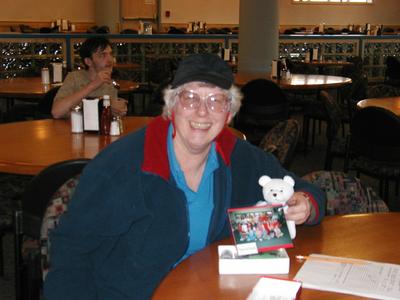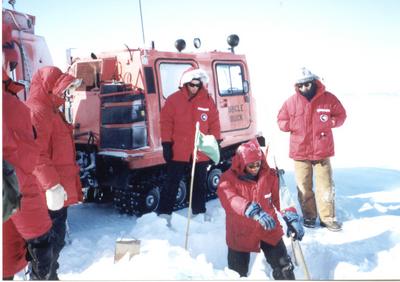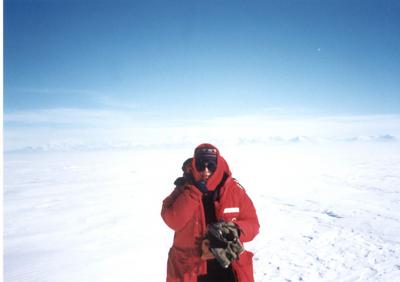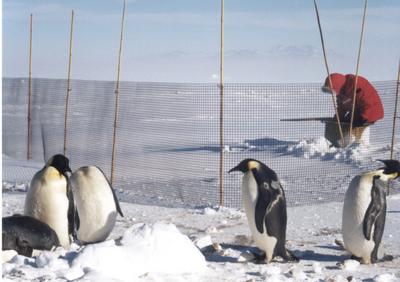
|
|
3 November, 2001
Today, I reported for sea ice training. Thai, our guide, has led
expeditions in the Himalayas and the Andes. We had to wear our full ECW
gear. The clothes really kept us warm, but I found that my nose forehead,
cheeks, and fingertips got to the point of "almost freezing" within a
minute.
The training today was a lesson on how to drill holes in the sea ice. The
drilling is important in order to determine the thickness of the ice. There
are several factors that could affect the conditions of the sea ice to make
traveling across it dangerous. The temperature, tides, heavy machinery,
and aircraft landing on the sea ice are just a few examples that could
affect the conditions of the ice.
As we traveled by Hagglund across the ice, this training proved to be
essential in knowing where to drive to avoid cracks and thin ice. The main
lesson for the day was that these precautions must be taken because "Ice
grows from the top down and melts from the bottom up, so just looking at
the surface of the ice will not tell you its strength." Thai had to use a
GPS (Global Position System) at times to maneuver his way around on the
ice. The wind had picked up, and as we drove from one drill site to the
other, the wind swept snow across the surface of the ice. The windows were
covered with frozen slush. This is Antarctica! Safety must be the number
one priority at all times.
We started our training at 9:00 a.m. and didn't return to the U.S. McMurdo
Research station until 7:00 p.m. Thai surprised us on the way back with a
side trip to a science station, called "the penguin ranch." There were
nine Emperor penguins at this location. Most of us took turns going down
into the long narrow tube, which ended in an underwater viewing chamber.
The Emperor penguins, the largest of the penguin families, were all huddled
together on land, so they couldn't be viewed swimming under water during
the time we were in the tube. Even so, I found it interesting to see the
underside of the ice. It gave me a better appreciation and a small glimpse
of the view that the scientists on my team have while scuba diving under
12-feet of ice. After taking a one-minute video, I had to go back inside.
The tips of my fingers were burning from the intense cold. It was -10
degree Fahrenheit, but the blustering wind made it a -40 degrees. The
digital camera had trouble operating in this extreme cold. Unfortunately,
I could not get pictures to share of this incredible day. Dr. Neil
Pollock, one of the scientists on Dr. Bowser’s team, told me that I had to
keep the camera inside of my coat and not in an outside pocket. He said it
would be best to keep it tucked inside my bib overalls. The batteries run
down faster when they get cold.
(I feel like Dorothy in the Wizard of Oz, I have to keep reminding myself
that I'm not in Kansas anymore.)

I brought Myrna Gary this geo-bear from Betty Trummel's fourth grade students in Illinois.

I am so thankful that I had another camera with me today. It was tucked into an inside pocket, so it stayed warm enough to capture a few photos. I couldn't post these until I had them developed "after" I got home. Thai, our sea ice trainer, offered instruction on how to drill through the sea ice. He also taught us how to recognize tidal cracks. (We could easily break or twist an ankle if we stepped into one.) This training proved to be invaluable! The "sea ice" was definitely part of my field experience!

I'm standing in front of our "classroom" for our sea ice training. We stopped here for further instruction and to get in out of the cold while we ate our sack lunches.

We spent the day drilling through sea ice. If the drill sites were close, we would walk from one drill site to the next. The Hagglund, our transportation vehicle for the day, drove on ahead of us. As we walked out across the sea ice, the snow blew across the surface of the ice. It was quite beautiful. This was the Antarctica that I had pictured in my mind. At times, I felt like I was on another planet!

Despite wearing two pair of fleece pants, bib wind pants, two pair of long underwear (including expedition weight), a turtle neck shirt, an outer shirt, a fleece jacket, a wind jacket, a big red parka, three pair of gloves, two hats, and my bunny boots, I was still freezing. The temperature dropped all day until it was -10 degrees Fahreneheit, with a wind chill of -40 degrees Fahrenheit. Yes, today I was cold!!! The sun and the reflection off the snow was so bright. It was imperative to wear sunglasses and sunscreen, which I found to be the case every day.

After being out all day, Thai made arrangements for our group to visit the Emperor penguin ranch. We were ecstatic! In this photo, the smile is frozen on my face, and my gloved hands no longer function. I am holding "Spike", the stuffed penguin, which I brought with me to remind me of my students. My students were my first thought when I saw the Emperor penguins. I knew they would love seeing these penguins as much as I did. I was freezing, but so overjoyed to be here! This was totally unexpected! I soon came to learn that Antarctica tends to hold many surprises when least expected.

The person in the red parka (in the background) is climbing into a long narrow tube, which goes beneath the ice. This access under the ice allows the viewer to see the underside of the ice, as well as Emperor penguins swimming under water.
Contact the TEA in the field at
.
If you cannot connect through your browser, copy the
TEA's e-mail address in the "To:" line of
your favorite e-mail package.
|
